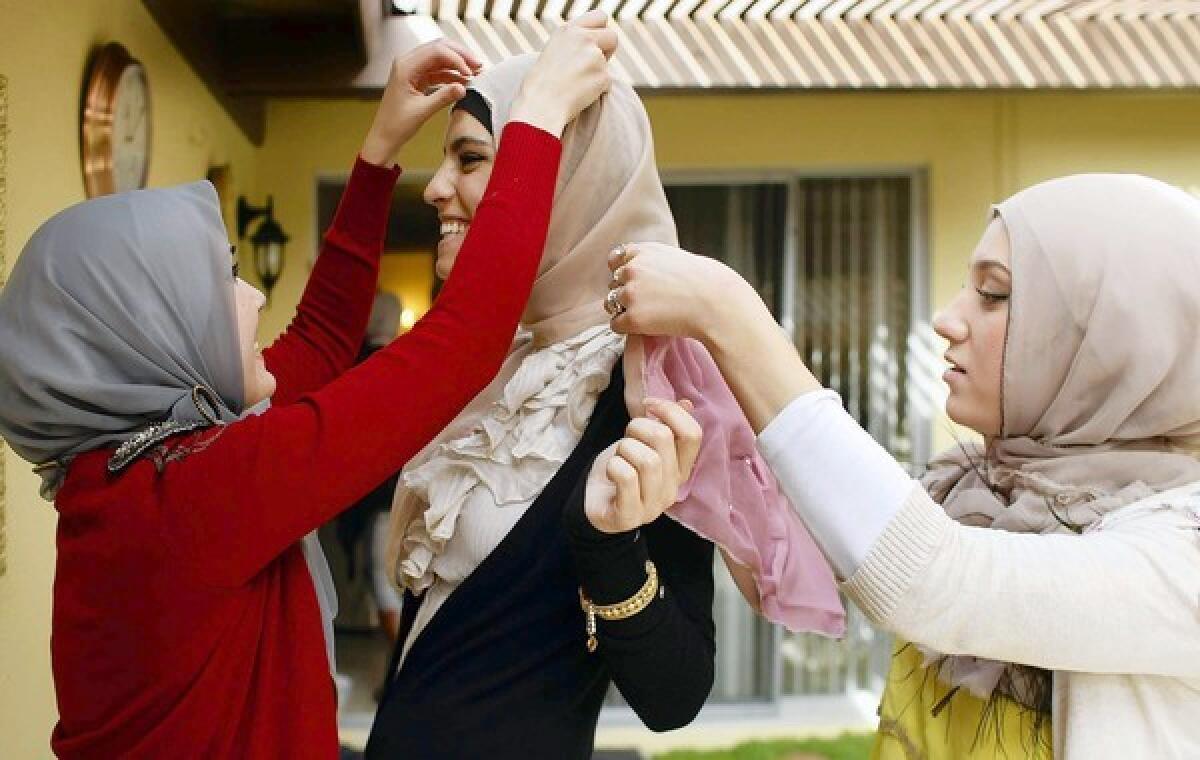Book review: ‘A Quiet Revolution’ by Leila Ahmed

- Share via
A Quiet Revolution
The Veil’s Resurgence From the Middle East to America
Leila Ahmed
Yale University Press: 352 pp., $30
When I was 13, one of my classmates came to school one morning wearing a beige head scarf. This was in the 1980s, in Morocco. Surprised by her attire, I joined a group of girls who gathered around her, watching them pepper her with questions. Our classmate calmly replied that she had decided to wear the hijab because that was what a “true” Muslim girl should do.
This struck us as strange. After all, we were Muslim girls too, but none of us, regardless of the degree of our piety, thought that our religion required us to cover. Yet just five years later, when I entered college in Rabat, the number of my classmates who had begun to wear the hijab had multiplied. And by the time I graduated, I was continually asked why I didn’t wear it. This phenomenon — the reappearance of the veil in the Muslim world, after several decades during which it had been on the verge of obsolescence — is the subject of “A Quiet Revolution: The Veil’s Resurgence From the Middle East to America” by feminist scholar and Harvard professor Leila Ahmed.
The resurgence of the veil is all the more puzzling, Ahmed argues, because it re-appeared first among educated women (the group that, several generations earlier, had been the first to discard it) and because the process seemed to be largely voluntary, taking place in countries where no laws coerced women to cover. This apparent conundrum, Ahmed explains, is the result of a combination of radical ideology and vast amounts of money.
The ideology came primarily from the Muslim Brotherhood, which in the years after Egyptian independence grew increasingly at odds with the socialist ideas of Egypt’s President Gamal Abdel Nasser. The Brotherhood, Ahmed writes, “affirmed the veil as a foundational Islamic requirement” and used it to signal “opposition to the dominant classes and the direction in which they were taking their society.” Interestingly, Brotherhood members were typically not trained in Islamic law — they were for the most part engineers, doctors or professionals — but they insisted on these interpretations, which were also aligned with specific political goals. In this context, the veil became a conspicuous signal of one’s disagreement with the ruling elite. And its propagation occurred not just through the mosques but through the many social programs run by the Brotherhood: daycare centers, schools, health clinics and even bus services.
As for the money, Ahmed writes, it came from Saudi Arabia, which was locked in a “fierce rivalry, dubbed the Arab Cold War,” with Nasser’s Egypt. Beginning in the mid-1960s, the Saudi government funded various organizations it saw as bulwarks against socialism and/or secularism. A condition of much of these funds was a strict adherence to the gender segregation that is a cornerstone of Wahhabi doctrine, and to the gender hierarchy that such segregation entails. Because of its nearly unlimited supply of cash, the influence of Wahhabi Islam spread throughout the Muslim world and had a homogenizing effect on clothing in the entire region.
Meanwhile, Muslims began to emigrate to Europe and the U.S. While European nations typically received immigrants from their former colonies, the U.S. was a destination for Muslims from many countries, resulting in an ethnic and cultural diversity that is perhaps seen only during the hajj in Mecca. That diversity and the high levels of education among this particular group of immigrants contributed to its economic success.
However, Ahmed writes, some among this group were committed Islamists who sought to propagate their ideas using the same methods that had been used in their home countries. Muslim Student Assns. appeared on many American college campuses and plunged into “the work of outreach, teaching and preaching.” Noticeably, such associations were often dominated by engineering or medical students, not by legal or religious scholars, and remained the purview of a small — but very organized — Islamist minority. So it was that the Muslim American majority was “essentially … left out of accounts of Islam in America.”
Ahmed is best known for the seminal book “Women and Gender in Islam” and the excellent memoir “A Border Passage,” both of which are testaments to her deep commitment to feminist — and secular — ideals. In this new book, however, she has had to revise her earlier perceptions and positions on the veil. The veil, she rightly argues, should be understood differently in societies like the United States, where women are free to wear whatever they want, compared with those, like Iran or Saudi Arabia, where women are now forced to wear it. (One might add yet another layer of difference here: The veil carries yet another meaning in societies like France, where the head scarf is banned in public schools and where the face veil is outlawed.)
In the United States, the organizations that had been started by homesick Islamist students are now run by their American-born children, whose ideas about what it means to be Muslim are different. The Islamic Society of North America, for example, elected a woman, Ingrid Mattson, as its president. A new translation of the Koran by Laleh Bakhtiar, a Chicago-based author and scholar, challenges orthodox interpretations of gender hierarchy. And under the leadership of the journalist Asra Nomani and scholar Amina Wadud, mixed-gender prayers have taken place in West Virginia. Nowadays, the women who cover are just as likely to do it for religious or political reasons as they are to do it in order to affirm their identity or take a stand against discrimination. Such developments, Ahmed writes, are “the first stirrings of a new era in the history of Islam and the West.”
“A Quiet Revolution” is an important book, even if at times it favors an opaque, academic language. It provides a thorough history of the resurgence of the veil both in the Muslim world and in the U.S. and adds significant nuance to the complex issues that surround the veil. Ahmed’s work will no doubt continue to inspire a new generation of Muslim feminists.
Lalami, the author of “Secret Son,” is an associate professor of creative writing at UC Riverside.
More to Read
Sign up for our Book Club newsletter
Get the latest news, events and more from the Los Angeles Times Book Club, and help us get L.A. reading and talking.
You may occasionally receive promotional content from the Los Angeles Times.








